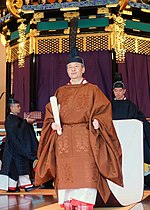Kodansha (1983). "Man'yoshu". Kodansha Encyclopedia of Japan. Kodansha. Nakanishi, Susumu (1985). Man'yōshū Jiten (Man'yōshū zen'yakuchū genbun-tsuki... 32 KB (3,299 words) - 02:02, 13 April 2024 |
 | The Shinsen Man'yōshū (新撰万葉集, "Newly Compiled Man'yōshū"), also called the Kanke Man'yōshū (菅家万葉集, "Sugawara no Michizane's Man'yōshū"), is a privately... 3 KB (254 words) - 02:26, 9 February 2021 |
 | Japanese poetry (section Man'yōshū anthology) most significant in the Man'yōshū, he rightly has a place as one of the most outstanding poets in Japanese literature. The Man'yōshū also included many female... 49 KB (6,798 words) - 10:13, 24 April 2024 |
 | Literature: From the Man'yōshū to Modern Times. Surrey, UK: Japan Library. p. 37. ISBN 1-873410-48-4. Vovin, Alexander (2009). Man'yōshū (Book 15): A New... 9 KB (1,053 words) - 16:19, 23 April 2024 |
 | A page from the Man'yōshū, the oldest anthology of classical Japanese poetry... 89 KB (10,125 words) - 11:36, 20 April 2024 |
The Man'yōshū, an 8th-century Japanese anthology of waka, survives in a number of manuscripts dating to the 11th century and later. The surviving manuscripts... 13 KB (1,157 words) - 14:24, 26 December 2021 |
Man'yōshū anthology Yamabe no Akahito 山部赤人 or 山邊赤人 (700–736), Nara period poet with 13 chōka (long poems) and 37 tanka (short poems) in the Man'yōshū... 10 KB (1,159 words) - 06:08, 11 April 2024 |
numbers indicate traditional attribution given as such in the Man'yōshū itself. (Man'yōshū poems that were attributed to these poets by later works are... 93 KB (1,989 words) - 23:10, 6 December 2023 |
Princess Ōku (section Man'yōshū poetry) Ōtsu. As a young girl, she witnessed the Jinshin War. According to the Man'yōshū ("The Anthology of Ten Thousand Leaves"), she became the first Saiō to... 8 KB (935 words) - 02:01, 28 February 2024 |
"Dark-water-snake", "Valley-water-snake", or "Female-water-snake". The Man'yōshū poetry collection mentions an Okami 於可美 "rain dragon" living on an oka... 12 KB (2,363 words) - 17:07, 28 March 2024 |
poet, nobleman and government official; the most prominent poet in the Man'yōshū anthology Princess Nukata 額田王 also known as Princess Nukada (c. 630–690)... 7 KB (762 words) - 01:08, 2 February 2024 |
Kujō house and tutored Yoshitsune in poetry. Man’yōshū jidai-kō is sometimes abbreviated as Manji 万時. Man'yōshū Jidai-kō deals simply with the question surrounding... 4 KB (489 words) - 03:25, 12 April 2024 |
Hideo Levy (category Man'yōshū) "The Victory of Japanese"; Kodansha 1992) Shinjuku no Man'yōshū (『新宿の万葉集』, "Shinjuku's Man'yōshū"; Asahi Shimbun 1996) Aidentitiizu (『アイデンティティーズ』, "Identities";... 9 KB (893 words) - 21:59, 26 February 2024 |
 | the poets included in the Man'yōshū, the oldest waka anthology, but apart from what can be gleaned from hints in the Man'yōshū, the details of his life... 33 KB (3,051 words) - 16:44, 23 April 2024 |
 | Genshō's time as sovereign. The Yamato state also produced fudoki and Man'yōshū, two more of the oldest surviving texts that relate the historical and... 29 KB (3,658 words) - 19:53, 27 March 2024 |
modern readers in the Man'yōshū, and when they are included in later poetry, it is to make allusions to poems in the Man'yōshū. The exact origin of makurakotoba... 13 KB (728 words) - 00:02, 19 March 2024 |
 | period, such as those contained in the Man'yōshū, the oldest extant collection of Japanese poetry. The Man'yōshū contained poems by people of every walk... 3 KB (391 words) - 11:32, 11 August 2023 |
 | Man'yōgana (category Man'yōshū) at least the mid-7th century. The name "man'yōgana" derives from the Man'yōshū, a Japanese poetry anthology from the Nara period written with man'yōgana... 24 KB (1,260 words) - 13:49, 7 April 2024 |
used by men (who were more educated). Man'yōgana (万葉仮名, kana used in the Man'yōshū): the most prominent system of magana. Sōgana (草仮名, sloppy kana): cursive... 31 KB (2,943 words) - 10:19, 14 April 2024 |
 | The largest and longest-surviving collection of Japanese poetry, the Man'yōshū, was compiled from poems mostly composed between 600 and 759 CE. This... 21 KB (2,415 words) - 09:16, 2 April 2024 |









